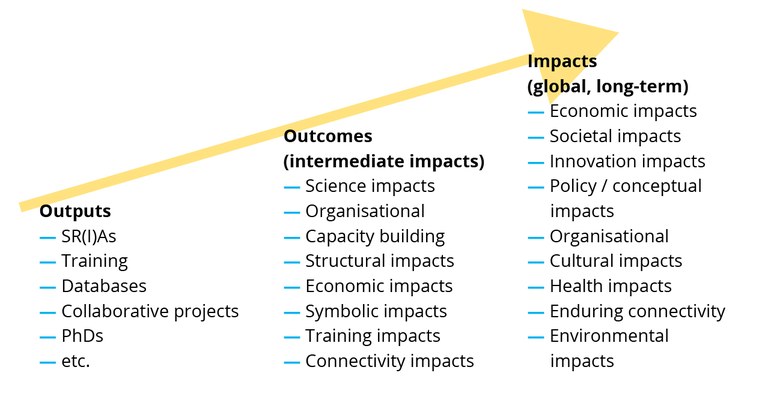Typology of impact types
There are different types of impacts depending on their content such as scientific impacts, innovation-related, societal, cultural, environmental, etc.
While these impacts come from the conduct of research i.e. at the project level of P2Ps, there are others that relate to the P2P as a partnership. These refer to connectivity impacts of P2P members, structural impacts.
Naturally, it is not possible to search for all impact types at the same time. The types of impacts to be anticipated depend on the nature of the activity/ies examined, the timing of the evaluation and the stage of development of the P2P. The two lists below are illustrative of all possible different types of impacts at partnership and project level. In a P2P evaluation certain types can be selected instead of others. The choice of impacts to be assessed should be clearly justified.

Read more about impacts at project level of a P2P and impacts at P2P partnership level.
Impacts at project level of a P2P
- Science impacts: research results have an effect on the subsequent progress and contribution to the body of knowledge. They affect the formation and development of disciplines as well as training and can also affect the development of a research field itself, generating interdisciplinary and international projects.
- Innovation impacts: product, process and service innovations as well as know-how partly result from research activities. There are few indicators for assessing this dimension, other than patents, which have generated some debate regarding their utility.
- Economic impacts: these refer to the impact on an organisation's budgetary situation, operating costs, revenues, profits, the sale price of products; on the sources of finance, investments and production activities; and on the development of new markets. At the aggregate level, they can also refer to economic returns, either through growth or increased productivity, of a given geographical unit.
- Cultural impacts: these relate to an individual's knowledge and understanding of ideas and reality, as well as intellectual and practical skills, attitudes, interests, values and beliefs.
- Societal impacts: research affects the welfare, behaviour, practices and activities of people and groups, including their well-being and quality of life.
- Policy / conceptual impacts: research influences how policy makers and policies act. It can provide evidence that influences policy decisions and can enhance citizens' participation in scientific and technological decisions.
- Organisational impacts: these refer to the effects on the activities of institutions and organisations: planning, organisation of work, administration, human resources, etc.
- Health impacts: these relate to impacts on public health, e.g. life expectancy, prevention of illnesses, quality of life, and the health-care system.
- Environmental impacts: these concern management of the environment, notably natural resources and environmental pollution, as well as the impacts of research on climate and meteorology.
- Symbolic impacts: these are the gains in areas such as credibility due to undertaking R&D or linked to universities or research institutions that offer gains in terms of potential clients, etc.
- Training impacts: these are impacts of research on curricula, pedagogical tools, qualifications, entry into the workforce, etc.
Impacts at P2P partnership level1
- Enduring connectivity relates to the on-going communication between the relevant actors and to the follow on collaborations that continue after the initial activity has been completed. This is connectivity that lasts beyond the first funded relationship. This type of impact refers to both P2P member organisations as well as their final beneficiaries. Retained collaboration through new projects or networks can be one example.
- Capacity building refers to the development/improvement of capabilities and skills in the P2P member organisations. The areas of skill development may include international programme/programme management, strategic thinking, international collaboration, international team coordination, etc.
- Attitudinal/cultural change relates to knowledge exchange and includes elements such as improved reciprocal understanding and willingness to work together among P2P current and potential partners. It may also refer to changes in research organisation such as adopting multidisciplinary approaches in research.
- Conceptual impact refers to the impact on the knowledge, understanding and attitudes of policy makers. In this category of impact we identify examples of changed thinking amongst policy makers, influences on policy issues and increased awareness in the policy world due to participation in a P2P. This type of impact at P2P partnership level can be paralleled to the policy impacts that may result from P2P funded projects. Policy impacts can influence national as well as European or international policies or strategies.
- Structural impacts relate to changes in institutions and structures in the national or European research landscape due to changed thinking amongst policy makers and influences on policy issues stemming from the acquired knowledge from participating in a P2P. The set-up of specific formal or informal structures in order to improve coordination at national level is an example of this type.
- Economic and symbolic impacts may also occur at the partnership level referring for instance to increased national investment in a specific area through P2Ps or reputation benefits due to increased international profiles of P2P partners.
1 adjusted from Meaghar’s impact framework

